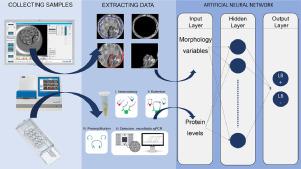Reproductive BioMedicine Online ( IF 4 ) Pub Date : 2020-10-08 , DOI: 10.1016/j.rbmo.2020.09.031 Lorena Bori 1 , Francisco Dominguez 2 , Eleonora Inacio Fernandez 3 , Raquel Del Gallego 4 , Lucia Alegre 1 , Cristina Hickman 5 , Alicia Quiñonero 4 , Marcelo Fabio Gouveia Nogueira 3 , Jose Celso Rocha 3 , Marcos Meseguer 6

|
Research question
The study aimed to develop an artificial intelligence model based on artificial neural networks (ANNs) to predict the likelihood of achieving a live birth using the proteomic profile of spent culture media and blastocyst morphology.
Design
This retrospective cohort study included 212 patients who underwent single blastocyst transfer at IVI Valencia. A single image of each of 186 embryos was studied, and the protein profile was analysed in 81 samples of spent embryo culture medium from patients included in the preimplantation genetic testing programme. The information extracted from the analyses was used as input data for the ANN. The multilayer perceptron and the back-propagation learning method were used to train the ANN. Finally, predictive power was measured using the area under the curve (AUC) of the receiver operating characteristic curve.
Results
Three ANN architectures classified most of the embryos correctly as leading (LB+) or not leading (LB–) to a live birth: 100.0% for ANN1 (morphological variables and two proteins), 85.7% for ANN2 (morphological variables and seven proteins), and 83.3% for ANN3 (morphological variables and 25 proteins). The artificial intelligence model using information extracted from blastocyst image analysis and concentrations of interleukin-6 and matrix metalloproteinase-1 was able to predict live birth with an AUC of 1.0.
Conclusions
The model proposed in this preliminary report may provide a promising tool to select the embryo most likely to lead to a live birth in a euploid cohort. The accuracy of prediction demonstrated by this software may improve the efficacy of an assisted reproduction treatment by reducing the number of transfers per patient. Prospective studies are, however, needed.
中文翻译:

基于整倍体胚胎蛋白质组学特征和囊胚形态的人工智能模型:初步研究
研究问题
该研究旨在开发基于人工神经网络 (ANN) 的人工智能模型,以使用废培养基的蛋白质组学特征和囊胚形态来预测实现活产的可能性。
设计
这项回顾性队列研究包括 212 名在 IVI Valencia 接受单囊胚移植的患者。研究了 186 个胚胎中每一个的单个图像,并分析了来自植入前基因检测计划中患者的 81 个用过的胚胎培养基样本的蛋白质谱。从分析中提取的信息用作人工神经网络的输入数据。使用多层感知器和反向传播学习方法来训练人工神经网络。最后,使用受试者工作特征曲线的曲线下面积 (AUC) 测量预测能力。
结果
三种 ANN 架构将大多数胚胎正确分类为引导 (LB+) 或不引导 (LB-) 活产:ANN1(形态变量和两种蛋白质)为 100.0%,ANN2(形态变量和七种蛋白质)为 85.7%, ANN3(形态变量和 25 种蛋白质)为 83.3%。人工智能模型使用从囊胚图像分析中提取的信息以及白细胞介素 6 和基质金属蛋白酶 1 的浓度,能够以 1.0 的 AUC 预测活产。
结论
本初步报告中提出的模型可能提供了一种很有前途的工具,可以选择最有可能在整倍体队列中活产的胚胎。该软件展示的预测准确性可以通过减少每位患者的转移次数来提高辅助生殖治疗的功效。然而,需要前瞻性研究。



























 京公网安备 11010802027423号
京公网安备 11010802027423号